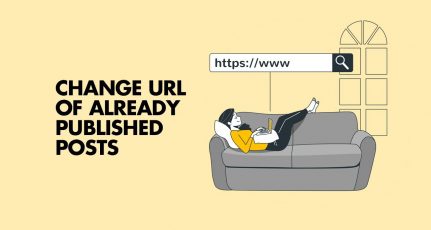
Do you want to write SEO friendly content?
Well, this is an art that could take your blog or your writing career to the next level.
Anyone can write an article, but it takes special kind of practice to write SEO optimized articles.
In this article, I will share some tips for writing SEO-optimized articles that will rank better in search engines.
I run multiple blogs and we have several authors working day and night to keep these sites updated with fresh, quality content. Sometimes, however, quality can drop (which usually happens due to a lack of knowledge).
Every blog post is like a web page in terms of search engine ranking and you can optimize each post with specific keywords for search engines.
When writing these SEO friendly articles, there are several things that you should keep in mind.
Whenever I hire a new author to work on one of our blogs, I have to give them manual inputs and checklists to help them to write better articles. Apart from selecting topics, there is a complete SEO checklist that must be followed.
(Note: I used to send this information out in an email to all the authors in my blog network. So I thought it would be a good idea to compile all of this information into a post. This way, ShoutMeLoud readers will also benefit from this information and learn how to write SEO articles as well.)
Also, note that in this post I will not be covering keyword research as it requires a detailed post of its own.
For more on keyword research, check out:
- Keyword research: The Beginners Guide
- SEMrush: A Practical Guide For Growing Blog Traffic
- Best Keyword Research Tools For SEO: Latest Edition
How to Start Writing SEO-Optimized Articles
Step 1- Start with research
If you really want to make a difference for yourself or for your clients, without research, you are simply shooting in the dark.
In this stage, you want to determine a few things:
- Keyword to target
- Length of the article
- Type of the article
- Analyze existing articles for outline
- People also ask questions
Do yourself a favor and get a tool like SEMrush first.
SEMrush offer free trial which will help you to do better research your topic and help in proper optimization of Keyword. This will help you to understand what is the right keyword you should be targeting.
Step 2- Type of content: Keyword Search Intent
Also, put your target keyword in the Google search to see what kind of articles are currently ranking. This is part of the research and will help you understand what kind of article Google think is better for such queries.
You may notice some pattern in the search result. For example, certain queries will only show listicles as shown in below screenshot:

Step 3- Find the ideal Length of the article
Use a SEMrush writing assistant to identify what is the ideal word limit you should have to increase your chance for ranking on the first page.
To use this,
- Login to SEMrush dashboard (Get 14 days free trial here)
- Under On-page & Tech SEO > SEO content template

- Enter your target keyword
- Select the Country and device you want to target

Click on “Create SEO template”
and it will show you the result as shown in the screenshot below:

As shown in the screenshot above, the first-page average word for my target keyword is 2182.
I would naturally ensure that my SEO optimized article should be at least 2100+ words. I have actually talked about this in-depth in my earlier guide on “Long-form content for SEO“.
Alright, once we are ready with these data, now is the time to create an outline.
Analyze the top 10 results for your target keyword. I know it’s a lot of tasks but again, if your goal is to Rank#1 on search, you need to take these extra step to stand out.
Here is a video tutorial where I have shown an example from another content optimization tool called Frase to find the ideal length of an article:
Based on your understanding, create an outline of your content. It’s a good time to learn about brainstorm and outline from this free guide.
Step 4- Scout People also ask
Search for your target keyword in Google search and it will show a section called “people also ask”.

Pick the questions that make sense with your article intent and answer them in your article. But, don’t stop here, as when you click on one of the questions, Google will add more questions after that.

This is one smart way to ensure your SEO optimized content answers queries that people are looking for.
Alright, now it’s time to start writing and optimizing your article for SEO.
Now, I use WordPress as my content management system and even if you are using something else, the next tips on SEO copywriting remain applicable to you.
Watch this video guide to learn more about acing this SEO copywriting hack:
If any particular step doesn’t make sense for you, do check our comment section as it is full of useful questions and answers.
1. Post Title and Meta Title
First, you need to understand the difference between post title and meta title.
- Post title: How your reader sees the title of the post on your website.
- Post meta title: How search engines show your post in search results.
If you have not specified a meta title in your SEO settings, your post title will be treated as the meta title.
- It is important to have your keywords in the meta title.
You can read more about this here:
Pro Tip: Keep your post titles less than 66 characters.
2. Post Meta Description
Every WordPress SEO plugin allows you to add meta descriptions to a post. These descriptions play a major role in search engine ranking.
Think of a meta description as a sales copy for your blog post:
- In 156 characters, you need to add your keywords and create a description that is seductive enough for users to click on it.
If you have not added meta descriptions in the past, you should start doing it immediately. Make sure to add your main keyword in meta description and make it intent driven.

Meta descriptions are very important.
You should go back to any of your previously published posts which do not have a meta description and add one.
By optimizing your post meta descriptions, you are ensuring that every post you write has the potential to drive a maximum amount of traffic to your site.
Google sees every blog post as a different web page so you can rank every post for certain keywords.
Meta descriptions are great places to put keywords.
3. Image Alt Attribute

Google can’t read images.
- Text is how Google recognizes an image.
To ensure that search engines can understand what an image is about, you must be sure to use proper image names.
Many people make the mistake of uploading images with names like image001.jpg.
- This is a huge mistake!
When naming an image, keep the name relevant to the image itself.
For example, if you take a screenshot of an AdSense dashboard, and you name the image “AdSense”, it will not be targeted. Instead, you need to use a name like “AdSense-dashboard”. This way, when people search for an image at Google Image Search, they will land on an image in one of our blog posts.
You can always manually add alt attributes when you upload an image.
I have seen positive results when using keywords in image anchor text ( and also when naming an image), so you should at least use keywords in your image alt text.
4. Interlink and Anchor Text
When writing a new post, it’s always a good idea to link back to old blog posts so that readers will stick around your site for longer and also so that search engines can re-crawl these old posts.
This helps in better navigability of your site which reduces the bounce rate- another important SEO factor.
When you interlink, you should use the anchor text technique.
Simply put, when you link to a blog post, you see an option to add a link and a title.
Make sure to fill out the post title with the main keywords for the post that you are linking to.

At ShoutMeLoud, we also use a plugin called LinkWhisper for internal linking.
5. Remove STOP words from Permalink

Words like “a” “an” “the” and many others which are listed here are ignored by the search engine.
Our post titles usually contain lots of stop words.
So for example, when we write a post with the title:
- 3 Ways to Make a Blog Business Plan
Our post permalink, by default, would be:
- domain.com/3-ways-to-make-a-blog-business-plan.html
“To” and “a“ are stop words in the example above.
You can click on edit permalink and change the permalink to “blog-business-plan”, thus eliminating the stop words.
- Important Note: Never change your post permalink once the post is published.
6. H1, H2, H3 Headings
Using the right heading tags is another important aspect of SEO copywriting.
You must not ignore one of the most important aspects of SEO:
- Using proper H1, H2, and H3 heading tags.
By default, in any SEO-optimized theme, the post title uses an H1 heading tag. So for the next sub-heading, you can use an H2 heading, and then an H3 heading, and so on.
It is always a good idea to use proper heading tags for effective SEO writing, especially when you are writing a long post.
Please refer to heading tags for SEO for a better understanding of how to use heading tags within blog posts.
According to the SEO community, it’s a good idea to use your keywords in H1, H2, and H3 tags. At the time of creating your outline (In the research phase), you should decide what your heading tags should be.
Final Checklist:
- Research for keyword
- Identify the right word limit
- Scout Google to find the right format for your article
- Create an outline by analyzing the top 10 results
- Make a list of questions from “people also ask” section of the search
- Post title for readers & meta title for search engine (keywords in titles).
- Post meta description (optimize it for better CTR and use your target keyword once).
- Image Alt text (use keyword).
- Interlink within a post using good anchor text.
- Post permalink (remove stop words from permalink).
- Use proper heading tags (keywords in H1, H2, H3 tags).
SEO Content Writing FAQs
To write SEO optimized content with ChatGPT, follow these steps:
– Start by researching suitable keywords using tools like Semrush or Google Keyword Planner.
– Find out the search intent behind the search queries linked to your target keyword.
– Determine the ideal article length by analyzing top-ranking results.
– Structure an outline based on top-ranking content and “people also ask” queries.
– Optimize your article’s elements like title, meta description, image alt attributes, interlinking, and heading tags using the targeted keywords.
1000 words can be a good starting point, but the ideal article length for SEO often surpasses this count. Longer, comprehensive content tends to perform better. Aim for around 2000+ words, especially if it aligns with search intent and provides in-depth, valuable information. However, give valuable, relatable, and exciting content to your audience. Instead of depending only on word count for higher search rankings, prioritize creating content that fulfills your user’s need and resonate with them.
For more SEO article writing tips, check out:
- How Outbound Links Improve Your Blog’s Authority & Ranking
- Best Keyword Research tools in any niche
- On Page SEO Techniques To Rank On First Page: New Edition
Let us know if you have any questions or if you have any other SEO writing suggestions. Share your thoughts in the comments section!
Do you know someone who can benefit from the information in this post? Share it with them on LinkedIn or Twitter.








Excellent post harsh 🙂
I am using the WordPress SEO along with All in one SEO. In there there is a column called “Focus keyword”. What i have to fill there?
Hi Harsh, thanks for your checklist! It is really useful for me! One question from me. Is it necessary to put keyword in H3 tag? I seldom use H3 tag in my article.
adding too much keywords to h3 h2 tages will make the pages keyword stuffed. it is bad seo. add h3 tags only if you have some thing. Use related words for that and no need to have exact keywords. it may cause SE to assess your post to be spams too. if your post has nice structure with one H1 and two or three h2 tags. That’s very much okay h1 h2 h3 tags are ways for SEs to understand whether you are writing a post in a good structured way.
wowo great article harsh 🙂 just wanted to ask about the title change…i sometimes have to change my title..i need to change some of the titles of the old posts as I didnt pay attention to this stuff at the begining.changging titles will hurt ? 🙄
meta data shoule be unique from other posts. and adding a keyword in first paragraph as well as image optimization.. and remaining all your mentioned 🙂 its a best post…
Thank you but I didn’t understand that we really need to keep the post titles maximum to 60 words? Or it need to be 60 characters?
Please me clear.
60 characters is what he mentioned. dont take it as a hard rule. try to make it in 60-70s maximum. you are already having a long title if you have 60 characters.
Harsh,
Its not only for guest writers but also applies to all the geeks. I think most of us know these thing but probably we are lazy to implement such seo things, on not only here (guest writers) but also on own blogs!
Thanks for the post!!
@Harsh.. Dont u use All in One SEO pack?
How to get that SEO details and additional styles?
Because Shoutmeloud use Thesis WordPress theme which includes SEO Details and Additional Styles option which works as All In One SEO pack.
Nice Post Mr-Harsh almost everything explained in detail.
Thanks
Really very useful article.
especially, I was not sure about how to set up H1, H2 ,H3 …. hehehe.. now I got it… how it can be set and it really works great.
Thank you for this post. I really wanted to know more about SEO. I would definitely follow all those steps in CAG, SML and TP as well as in my blog.
Great tips, and refresher. At times we can easily miss these out, taking time out to ensure that every element of your article is optimised will definitely pay off over the time. As it only takes an extra few mins to carry out these tasks.
Thanks for your advices. This post contains a lot of useful information! The theme I use on my blog uses H2 as default for post titles and if I use the H tags in the text the padding and stuff is all messed up.
Guess I have to fix that.
Thanks again, also for the hints concerning giving tags to articles 😉
You did it really great by publishing the email publicly. Very useful post for everybody so that they can pay more attention to the SEO and do the required. The tools and plugins you mention are wonderful. Its a real gem indeed. Thanks for sharing it.
I suggest use some free services to research keyword, such as: google trends, google keyword tool, google insights, etc.
Or some paid plugins for wordpress: keyword winner, seo scribe.
I’ve used them and they work very good
Great post, really. I tend to do the mistake of spamming too common keywords on the meta tags (or even keep them blank) 🙁 It’s a new tip for me to be honest and I should do that from now on my every post!
Why we should use keyword field in all in one seo plugin to get ranking on those keywords, if we are already getting traffic from keywords related to those posts? I am confused. I never used keyword option for my blog because my blog posts are on top for the keywords on which I have written the post. can you please give me solid response so that I should start using that option 🙂 ? Thanks..
Great tips Harsh.Learn lot of new things related to SEO from your post.I’ll try these tips on my upcoming blog posts.
This si the first article which I’ve read on how to upload a Blog Post. There are many articles on how to write a good blog post but barely any on how to upload them. Loved this so much that i’ve added this to my favorites.
is the tip still working after panda update ??
Good tips, harsh. One thing I would like to ask in regards to the 2nd tip, i.e keyword selection. Like you wrote someday ‘8 things after installing wordpress’. What keywords should we use in such posts ?
Waiting for your reply.
Garish first step would be to find the best keyword and that you can take help of Keyword Suggestion tools. But anyways, if you write a post without doing a keyword research, you should think from a readers perspective that what keyword you would be using for searching something like that ” WordPress essential setting” “Steps after installing WordPress” and so on…
Thanks for suggesting.
But that post ‘8 things after…….wordpress’ contains 8 things and all that 8 terms are usually searched like wordpress permalink structure, wordpress security.
Now my question is, should we target this with all the 8 keywords or only the ‘steps after installing wordpress’ or both. Thanks, kindly reply.
I think you can target it on both, so that you get better views from Search engines.
Garish you meant keyword like:
WordPress permalink setting, WordPress discussion setting, WordPress privacy settings and so on??
If your answer is yes, then you can… But then use proper header tags and make sure you use a descriptive amount of words to explain those sub headings…!!
Yes Harsh, I meant that Keywords. Can We rank higher in Search Engine for all those keywords for the same post. As you and other webmasters say to focus on only one keyword per post, will not this contradict it. Also google will divide the priority into 8 keywords (if we use 8) instead of one and thus we will rank lower. Isn’t it ??
Sorry, I am asking too much.
Too many keywords in a single post may lead to keyword spamming. It’s better to narrow it down and target for 2-3 keywords. Just my 2 cents.
Thanks for the reply. I got it now that we should focus on 2 -3 keywords only in one post and we can create another post for any other keyword related to it.
I think harsh Using Keywords Is no longer effective because google last year announced that it does not use Keywords to rank Pages, instead meta description Can do great wonders!
Hi Harsh,
Just a couple of questions.
1.How does the changing of a post title(after publishing the post) and republishing effects the blog? I remember reading somewhere that google will stop indexing it if we change the title after posting once. How true is that?
2.In your post you have mentioned not to change the permalink after posting. What are the consequences of it?
3.Even the permalink of this post contains stop words ( How, to). Isn’t that contradicting your post?
Thanks much for the help. Looking fwd for your reply
Hey Renu
One should not change the permalink else it will be broken link for old permalink but if you set a 301 redirection, it should not be an issue..
Changing post title later on is a bad thing in terms of search engine.. As your old post is already indexed and crawled by Google and post title tag is an important part of it….If you change your post title tag a lot, Google might take it as one of the spamming activities. As Google has already given ranking to that page because of it’s current SEO factor and if that page is performing good in search engine, you might not like to play with it’s on-page SEO structure…
In this post I have removed the last stop words “In” and rest “How to” and other keys are important..!!
All great tips – a lot of bloggers leave out some of these which can have serious consequences when it comes to getting traffic from search engines.